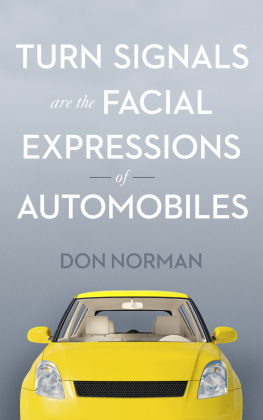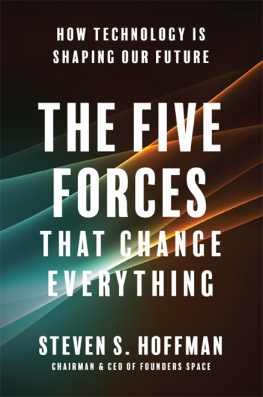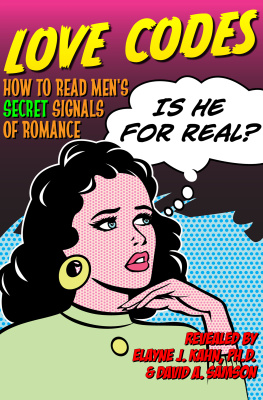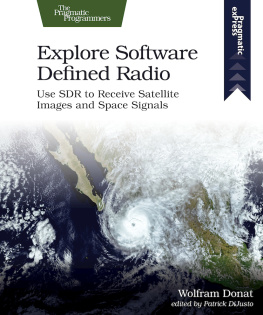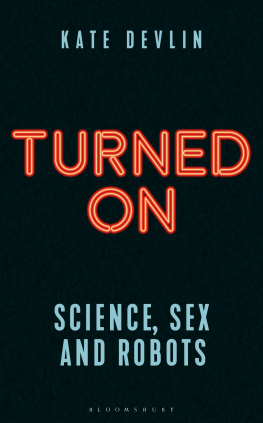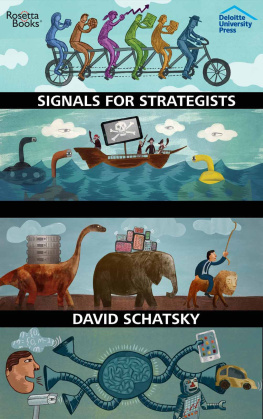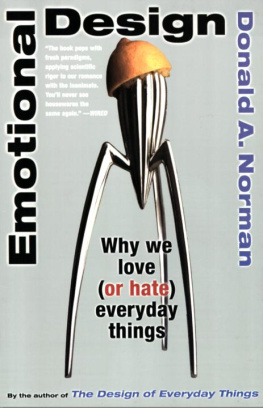Turn Signals are the Facial Expressions of Automobiles
Don Norman
Copyright
Diversion Books
A Division of Diversion Publishing Corp.
443 Park Avenue South, Suite 1008
New York, NY 10016
www.DiversionBooks.com
Copyright 1992 by Donald A. Norman
All rights reserved, including the right to reproduce this book or portions thereof in any form whatsoever.
This Is Just to Say is taken from The Collected Poems of William Carlos Williams, 1909-1939, vol. 1. Copyright 1938 by New Directions Publishing Corporation. Reprinted by permission of New Directions Publishing Corporation.
Many of the designations used by manufacturers and sellers to distinguish their products are claimed as trademarks. Where those designations appear in this book and Addison-Wesley was aware of a trademark claim, the designations have been printed in initial capital letters.
For more information, email
First Diversion Books edition December 2014
ISBN: 978-1-62681-536-0
Also by Don Norman
To my parents:
Miriam F. Norman
Noah N. Norman
Contents
Preface
Some people watch birds. Others watch people. Some watch cars or boats, or sports. I watch technology, especially the small, common, everyday variety. In particular, I watch the way people interact with technology. I am not happy with what I see. Much of modern technology seems to exist solely for its own sake, oblivious to the needs and concerns of the people around it, people who, after all, are supposed to be the reason for its existence.
The dehumanizing nature of modern technology has long been a theme for concern. My goal is neither to attack nor to defend but to understand just how the interaction between person and technology takes place, to discover where and why difficulties appear, and then to try to do something about them. You might say that my goal is to socialize technology, to humanize technology.
Society has reached the point where it would be completely unable to function without technology. Our social judgments, our skills, and even our thoughts are indelibly affected by the nature of the technology that supports us. Worse, the impact is so pervasive, so subtle, that we are often unaware of how many of our beliefs have been affected by the arbitrary nature of technology.
This book touches upon some of the critical issues. The chapters are meant to inform as they amuse. Some are deliberately provocative. But I am serious about the main message: Technology tends to dehumanize. This is not a necessary part of technology, but it relentlessly encroaches upon us unless we exert caution. Technologists tend to create what technology makes possible without full regard for the impact on human society. Moreover, technologists are experts at the mechanics of their technology but often are ignorant of and sometimes even disinterested in social concerns.
I believe that we can create a humane technology, one that serves and enhances people and society. But this wont happen unless educated, concerned people take a hand in the design and application of our technology. This book provides some starting points. It provokes, scolds, and speculates, all with the aim of increasing our sensitivity to the dehumanizing aspects of technology, and helping us to realize that we can cause it to be otherwise.
Acknowledgments
I am grateful to many for their assistance and comments on these essays. My academic colleagues have provided much of my initial stimulation and my interactions with industrial developers and researchers have increased my appreciation for the difficulties of bringing technologies to the marketplace. I am grateful to all my colleagues.
I especially thank Mike Shafto and Ev Palmer at NASA Ames Research Center (who also support my research through the NASA Aviation Safety Program), my colleagues at Apple Computer, Inc., and Digital Equipment Corporation, who have also helped support this research, and especially to Tom Erickson and Jim Spohrer at Apple for their comments on the manuscript. Julie Norman was a perceptive and properly critical reader of the early drafts. William Patrick at Addison-Wesley provided a useful scolding about the excesses of earlier drafts, telling me what was nonsense, helping me shape these essays into coherence, yet without losing either the fun or the message. This book might not have been written at all if it were not for the encouragement of Sandra Dijkstra, my literary agent, who was always there when needed.
At the University of California, San Diego, Michael Cole continues to educate me about the nature of mind and culture; Edwin Hutchins has provided critical insights about the way that cognition is distributed over time, space, people, and things; and Hank Strub, Emmy Goldknopf, and Cyndi Norman kept plying me with critical readings, critiques, and queries, all to the eventual betterment of my own understanding. Comments have come from all over the world through the power of the electronic mail and bulletin boards that link the universities of the world (see, for example, , which is entirely the result of electronic mail interaction).
A book is the joint effort of many people. My experience has provided a wonderful example of how the interaction of cognition, technology, and social interactions can merge to aid human activity. Technology can be effective, supportive, and humanizing, if only we insist that it be so.
D.A.N.
Del Mar, California
Chapter Notes and Book Design
Nothing seems to create more controversy about the design of a book than the placement of notes for each chapter. Academic readers are used to seeing notes at the bottom of relevant pages as footnotes. Trade publishers do not approve. They feel that notes distract, breaking the flow of reading. They prefer to hide the notes at the end of the book out of sight, but still available for the serious reader.
Many of my readers have complained vociferously. The notes are hard to find, they say, and it is particularly disruptive to keep two place markers, one for text, one for notes. Alas, I know of no data relevant to the relative proportion of readers who might fall into each category, the one described by the publishers or the one corresponding to those who write me. Each side argues that the other constitutes a tiny minority.
For this book, we are trying a compromise. Important comments have been put directly in the text. Notes are used primarily for references and acknowledgments. I have kept substantive comments to a minimum. This should minimize the need to turn to a note. Each note specifies the chapter number, name, and page from which it has come, with a short quote from the text indicating the section to which it refers. This makes it easy to go from the notes back to the text, a feature many readers requested.
There still remains the question of how to tell the reader that there is a relevant note at the back of the book. Traditional footnote symbols are thought to be disruptive, diverting the readers attention to the note, usually to find that it does not contain essential information. We are trying a more subtle signal. The mark * appears whenever there is a substantive comment in the chapter notes. Notes that contain only a citation to the published literature or an acknowledgment are not marked in the text.
1
I Go to a Sixth Grade Play
I went to a sixth grade play. It was a small play, at a small school. Only the sixth grade was involved, so we were in a relatively small auditorium, with approximately fifty folding chairs crammed together on the floor. If there had been only fifty parents present, it would have been crowded. But in addition to the parents, we had the video cameras.

